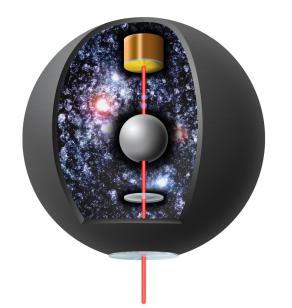Aug 21 2015
Two new reports advance efforts to identify components of dark matter and energy, which together comprise about 95% of the universe yet leave much to scientists' imaginations. Both experiments illustrate how basic questions about the universe's development can be addressed by laboratory-scale experiments.
 This is an artists' impression of the experiment. The conditions in the vacuum chamber and the use of individual atoms (violet dots) as probes simulate the conditions in empty space for the search for dark energy. Credit: Simca Bouma
This is an artists' impression of the experiment. The conditions in the vacuum chamber and the use of individual atoms (violet dots) as probes simulate the conditions in empty space for the search for dark energy. Credit: Simca Bouma
In the first report, Elana Aprileand colleagues - members of the XENON Collaboration - report on their search for dark matter, a hypothetical matter, the existence of which is inferred from its gravitational effects on visible matter. While gravitational processes have been thought to involve standard model particles like neutrinos and photons, more recent studies of the physical processes forming our universe suggest new particle types - like WIMPs (or weakly interacting massive particles) - are involved. Experiments that test this notion look at how these proposed dark matter particles interact with standard particle types; for example, when WIMPs and standard model particles interact, they create recoiling charged particles visible in detectors like the underground XENON100 detector located in Italy. Here, Aprile and colleagues used this instrument, a large tank of liquid xenon that forms a target for WIMPs, to detect distinct signals from recoil. With no evidence for particular signals, their results set limits on several types of dark matter candidates that have been proposed.
Paul Hamilton et al. searched for a hypothetical force called a chameleon field, one of the most prominent candidates for dark energy - a force thought to have propelled the expansion of the universe. For about a decade, scientists have been looking for a chameleon field, which modifies the wave functions of matter. Here, in searching for a source for these fields, Hamilton et al. used a light-pulse atom interferometer. Their experiments greatly constrain existing theories of dark energy. A Perspective by Jörg Schmiedmayer and Hartmut Abele provides additional insights into both reports, which tackle some of the most pressing issues of current physics.